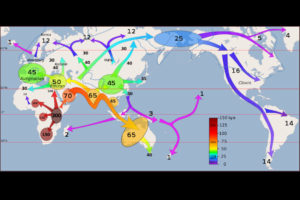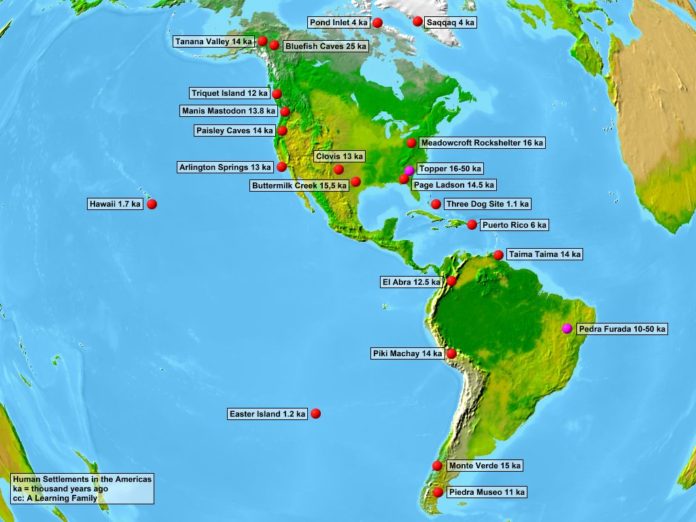Understanding the peopling of the New World begins with the study of prehistoric human settlements. The first Homo sapiens left Africa about 300 thousand years ago (KYA). However, the settlement of the Americas came much later – about 25 KYA ago. The Last Glacial Period is key to understanding human settlements in the New World.
The Ice Age and Prehistoric Human Settlements in the Americas
The Last Glacial Period
The Last Glacial Period took place between 115 and 12 KYA. However, the last period of maximum glaciation occurred from 26 – 20 KYA. During this period, huge ice sheets covered North America, northern Europe, and Asia. The Earth’s climate was greatly changed. Sea levels dropped over 50 meters. The drop in sea level created a land bridge between Asia and North America. This is known as Beringia or the Bering Land Bridge. The land bridge existed from 30 to 10 KYA.
As a result, prehistoric animals and humans crossed the land bridge between Asia and North America.
Human Settlements in the New World

The earliest human settlement in the New World are the Bluefish Caves. This settlement dates between 40 and 25 KYA. The primary evidence comes from bone tools used by humans. The caves are located in northwest Canada. From Canada, there are several paths that humans followed.
Pacific Coast: One major path follows the Pacific coast. It runs from North America to the tip of South America. These sites run from the Tanana River in Alaska to Arlington Springs in California. These settlement sites date from 12 to 14 KYA. Other sites are Triquet Island, Manis Mastodon, and Paisley Caves.
Settlements that date from 11 to 15 KYA run along the Pacific Coast in South America. These sites are El Abra, Piki Machay, Monte Verde, and Piedra Museo.
Central North America: A second major path runs from Alaska to Central North America. This includes the Clovis and Buttermilk Creek sites (13 – 15.5 KYA). In addition, this path splits to Eastern and Southeastern North America. In turn, these sites date from 14.5 – 16 KYA. This includes Meadowcroft Rockshelter and Page Ladson.
Arctic North America: The third major path runs across the Arctic from Canada to Greenland. Pond Inlet and Saqqaq date 4 KYA.
Uncertain Sites: Two sites are much older than these sites. Topper in South Carolina is dated from 15 – 50 KYA. In a similar fashion, Pedra Furada in Brazil is dated from 10 – 50 KYA.
Reflections
Vocabulary
- Beringia
- land bridge
- settlement
Notes
- During the last glacial period, a land bridge connected Asia and North America.
- Modern humans crossed this land bridge about 25,000 years ago.
- At least two of the settlement sites could be 50,000 years old.

